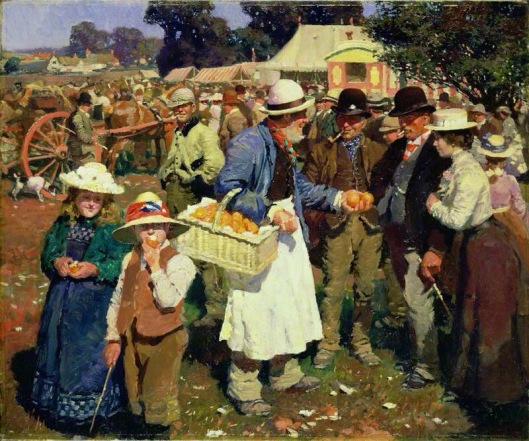A few days ago, through talking to a gentleman who is making a study on the history of Mendham, where as other posts have detailed, many of my family lived, I was made aware that the painter Sir Alfred Munnings, who was brought up in the village, named some of the locals – including a character he called Old Norman – in his autobiography, and I bought a copy of this book.
What a revelation! For Old Norman is clearly my 3rd great grandfather James Norman, and he appears to have worked for Munnings and to have been a close friend. Furthermore, Old Norman’s son in law Dan Betts – my 2nd great grandfather – appears with him in at least one painting, alongside two of Dan’s children!
Daniel Robert Betts is referred to in Munnings’ autobiography as ‘one of our carters’ and as I knew from census returns this was his occupation, I now know his employer – Munnings’ father ran Mendham Mill and my nan told me the Betts family lived, around 1900 when the pictures were painted, in a cottage by the river near Shotford Bridge, which would have been a short walk across the fields from the Mill.
Dan is described as wearing small silver earrings, and having a moustache which he shaved off to sit for the painting: ‘and became so transfigured that his wife and family didn’t know him. A kind man and father.’
In ‘A Gala Day’ (below) Dan stands, pipe in mouth, wearing a brown jacket and waistcoat with a blue kerchief, in a small group alongside Hoppy Daniels, who we learn was lame, and Polly Scotchmer from the Red Lion, being offered oranges by Old Norman. Next to him are two of Dan’s children, Jimmy, eating an orange, and Tilly, peeling one.
Munnings introduces the family thus: ‘At the time, I was beginning to employ an old son of the soil; and we formed a friendship which lasted until he died.
His name was Norman. He was a grandfather many times over. Dan Betts, of whom I have written….was his son-in-law. Betts’ children are in the Whitsuntide picture, and grandfather Norman is there, in a white hat with a blue linen coat and white apron. His all-round grey whiskers are worn in this picture. He was over eighty – active and strong, hale and hearty; – a nature’s gentleman, a swell of the soil. Indeed, one of the ‘rude forefathers of the hamlet’ if ever there was one. He had a fine countryman’s face, a good nose, and a well-shaped mouth. His top lip and chin were clean shaven in the fashion of Mr Watchhorn…..He often wore one of those hundred year old smocks seen in Leech’s drawings, and either a corduroy and drab bet waistcoat or a truly cut countryman’s jacket of earlier days. A coloured handkerchief, bird’s eye, was worn round the neck. His cord trousers were tied below the knee, and sometimes he wore a closish fitting pair of horseman’s breeches and box leggings.’
Munnings describes seeing his ‘staunchest friend’ working in his three cornered garden, and his dwelling has been identified from the book as what Mendham folk now call ‘the Coal House’ since it is thought its first use was to house the coal supplies for he whole village, from where they were doled out.
Old Norman was an accomplished horseman, gardener and rock maker – as in sweets. Munnings describes watching the old man make the rock in his small house, and taking it on a hand cart (which Munnings decorated with pictures and slogans for him – what would that cart be worth today??) into Harleston to sell. He also acted as butler during sausage suppers at the Red Lion – though he clearly also ate – and drank – his share, before being ‘seen’ (a euphemism for carried?) home at one in the morning.
Helping to deliver a grand piano however, he was mystified as to what the object was and apparently exclaimed upon hearing it played: ‘well…. That dew wholley stam me!’
Munnings also recounts the stories Old Norman told of his early life. Being born in 1816, by the time he knew the painter he would indeed have been around eighty, and he lived through the ‘hungry forties’ – that’s 1840’s, when he went bird scaring and stone picking, in his home village of Metfield, and later walked five miles to work digging drains for nine shillings a week, while his mother did washing and farm work. ‘He never went to school,’ Munnings tells us, ‘but he knew all about the beasts and the soil.’
In 1840 he married Elizabeth Watson in Metfield: she died in 1886 and they had fifteen children including my great great grandmother Matilda. Yet Munnings tells us that the love of his life was a young widow who lived in a cottage in the fields and made leather gloves for hedging: he regretted not marrying her although he had a good wife in the end. Personally I’m glad he made the choice he did, since his wife is my direct matrilineal ancestor.
He knew what it was to go without so that his children could eat, and in 1851 he went to London to work on the ’51 Exhibition’ as he called it. To save his earnings he would walk the hundred miles home to Metfield, getting lifts on wagons where he could and sleeping under haystacks.
He is described as still hale and hearty when in 1903 he was gathering apples, standing on a ladder. Unfortunately the ladder slipped and he fell, later dying from the effects of this.
There are other paintings, such as ‘The Woodcutter’, and sketches featuring James Norman, and thanks to Sir Alfred Munnings I now have a detailed impression of my 3rd great grandfather and more information on my family’s past.

